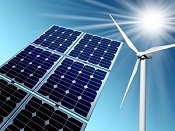South Australia has rightly been acclaimed as a leader in renewable energy. Already 38% of their electricity comes from wind and solar. Yet
- Futures contracts on the ASX Energy market for electricity delivered in 2016-2018 are between $86 and $90 a MWh in South Australia, compared with between just $37 and $41 MWh in Victoria and between $43 and $48 MWh in NSW.
What’s going on?
The Australian Financial Review has run a series of articles on the issue.
When the wind is blowing strongly power costs literally less than nothing. When the wind fails, the price sky-rockets. Backup comes in the first instance from Victoria’s brown coal power. Recently when that failed local coal and gas-fired power came to the rescue, forcing the wholesale price up to about $2400 a megawatt hour. On several occasions in recent months prices have hit the National Electricity Market limit of $13,800 a megawatt hour.
In similar circumstances Germany, Italy and Spain draw electricity via interconnectors to France, which has plenty nuclear power. France is planning six new interconnectors worth $250 billion. They expect to make money.
Ironically Germany is closing its nukes, but in doing so draws more power from France’s nukes. SA closes coal and gas and ends up depending on brown coal.
Of course gas is more suitable than coal as it can be fired up quickly.
Tristan Edis, now an energy analyst at New Energy Economics, says the market should be left to sort it out. He points out that two of the major gas generators have either been mothballed or are announced to be mothballed. If the price is right perhaps they will stay.
The best answer may lie in what’s being called ”hydricity”. Solar or wind could be used to make hydrogen, which could then be burned as required to generate back-up power. The hydrogen comes from water and then oxidises back into water.
The electricity situation in SA is particularly acute in the case of Dutch company Nyrstar’s plans to redevelop the Port Pirie lead smelter. The project is to be supported by $291 million of SA taxpayer money, but electricity now looks like being twice as expensive as it was when the project was announced.
Politically the project is tricky because Port Pirie is “in the electorate of Geoff Brock, an independent MP who was the kingmaker last year who helped install Mr Weatherill as premier after a cliffhanger election.”
Brock was rewarded by being made regional development minister.


Giles Parkinson over at Renew Economy thinks this is largely a beat up http://reneweconomy.com.au/2015/australias-right-wing-media-declares-new-war-on-wind-and-solar-94168
At the risk of sounding like a conspiracy theorist, I wonder if there might be non-commercial aspects to this whole matter.
(1). Casting any sort of doubts on renewable sources of energy would suit the knuckle-walkers and the fanatical worshippers in the Temple of Holy Market Forces right down to the ground.
(2). Winds rise and fall. They always do. When grown-ups make arrangements to use wind as a source of power, you would expect they would make several DIFFERENTcontingency arrangements for whenever there was too much or too little wind as well as for the inevitable need to halt machinery from time to time.
Should we wait for another decade or two, until the kiddies grow up and learn to use the big, shiny toys with which they have been entrusted.
I say can the Coal and Gas backup in SA and Nuke in Europe.
Raise some more tax from the other States.
And Robert’s ya Mums brother in the dark.
Silly market manipulation and sub efficiency preference consequences.
Obviously Murdoch ( spit ) has some serious questions to answer here !
( just kidding 🙂 )
Doug, thanks for the Parkinson link which wasn’t available when I wrote the post.
However, I can’t see that the problem is just a beat-up in the immediate to mid-term.
That’s the reality.
On the more general nature of the problem, Ben Potter, who I don’t think is a right-wing shill, quotes Matt Zema, chief executive of the Australian Energy Market Operator, the bloke who runs the show whose stuff Parkinson says Potter should read.
No doubt all will be resolved when battery storage becomes available at competitive prices. Conceptually I like the hydrogen solution.
Brian: I don’t like the hydrogen solution because storing hydrogen is so difficult. May make more sense to convert the hydrogen to a transport fuel such as liquid ammonia for selling as transport fuel and backup fuel.
SA could also use some solar towers which come with low cost molten salt storage. Back-up is cheap in the form of the molten salt backup heater.
I dunno, John. Perhaps hydrogen is not such a problem if you don’t have to transport it.
Molten salt could be used for filling in the nights, but I’d doubt it has the flexibility over time to serve as a genuine backup facility.
Brian: Molten salt heat storage is the way energy is installed in the large scale solar systems installed around the world.
The salt used is a mix of potassium and sodium nitrates – both low cost and plentiful. They can be stored in steel tanks.
The BZE plan was based on enough salt to store about 3 days worth of heat. Back-up molten salt heaters have low capital costs.
Not sure what it would cost to have the equivalent safe hydrogen storage.